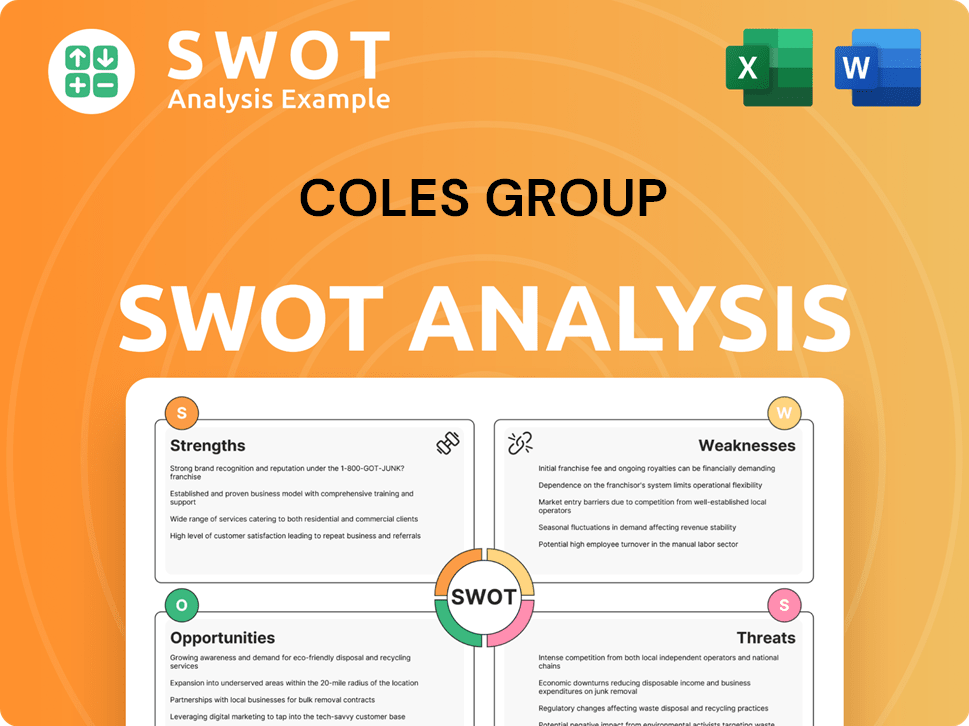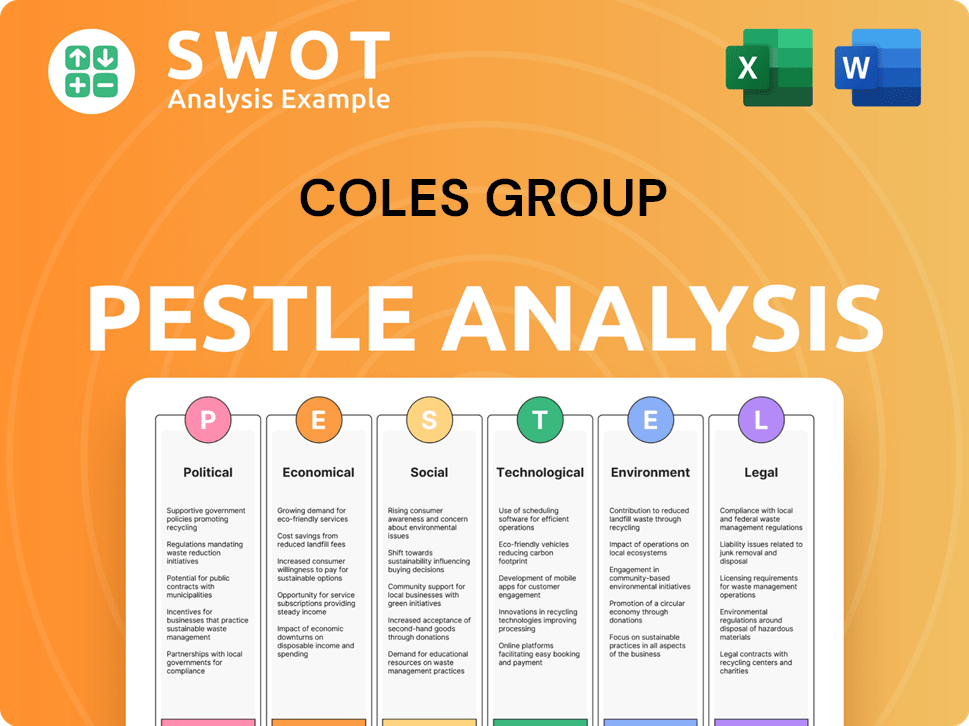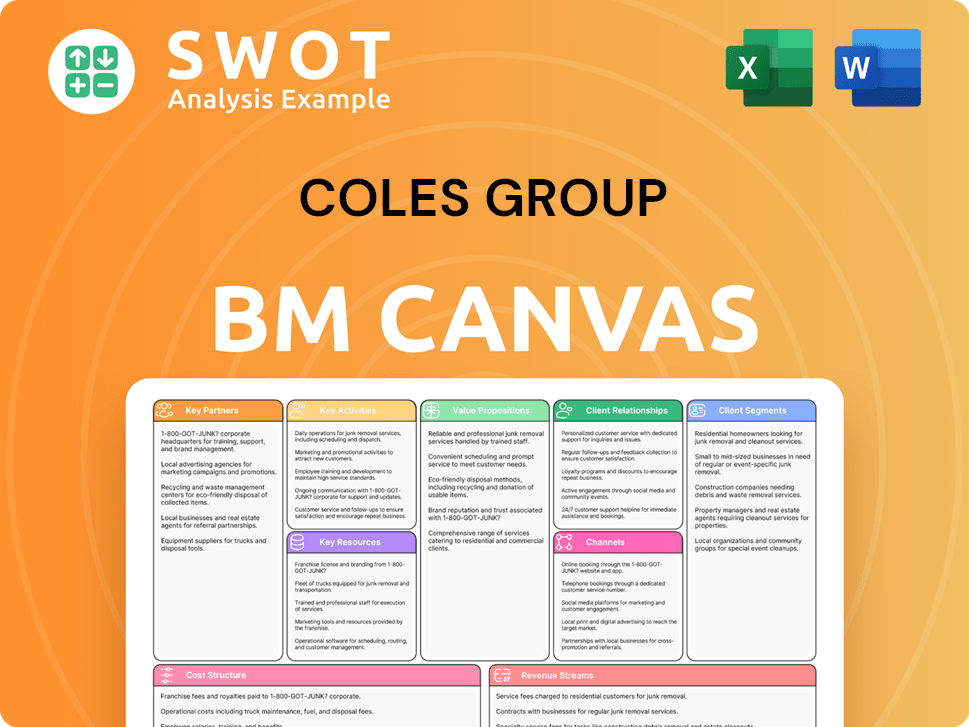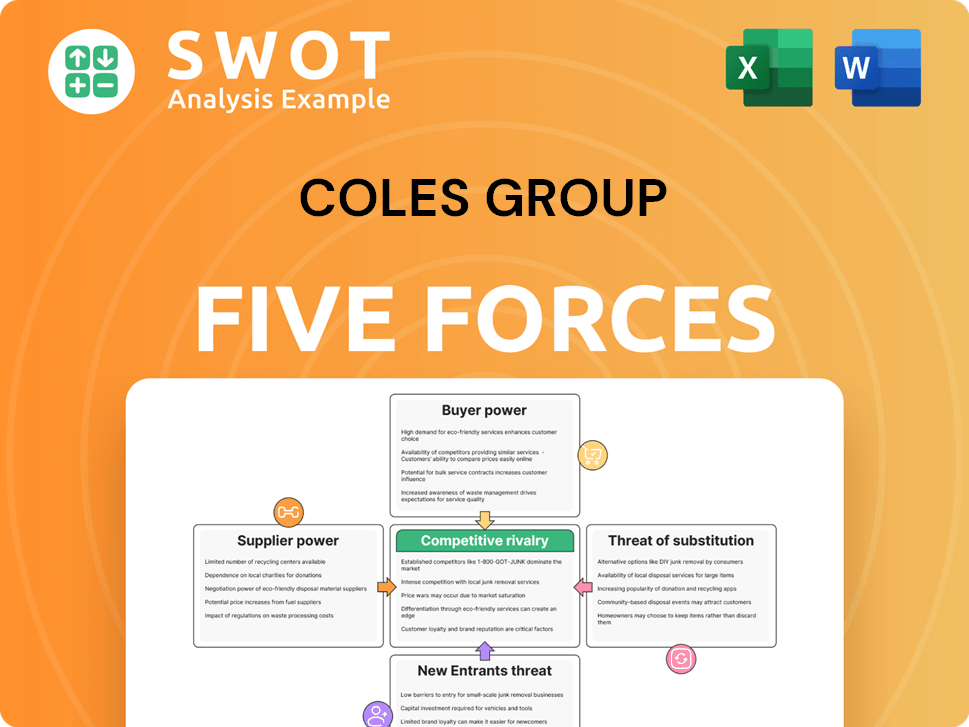Coles Group Bundle
How is Coles Group Dominating the Australian Retail Market?
Coles Group, a titan of the Australian retail landscape, has consistently adapted its sales and marketing strategies to thrive in the dynamic grocery and liquor markets. From its humble beginnings in 1914, Coles has transformed into an omnichannel powerhouse, serving millions of customers weekly. A cornerstone of their success is a steadfast commitment to providing value and quality, especially crucial in today's economic climate.

This article will explore the intricacies of the Coles Group SWOT Analysis, delving into its effective sales channels, integrated marketing tactics, and brand positioning within the competitive Australian retail market. We'll examine how Coles Group's sales strategy, including its digital marketing initiatives and loyalty program strategy, has driven impressive financial results, such as the A$43.6 billion in sales revenue reported in FY24. Furthermore, we'll analyze the impact of key campaigns and ongoing digital transformation on its market share analysis and future growth strategies.
How Does Coles Group Reach Its Customers?
The sales channels of Coles Group are a blend of physical and digital platforms, designed to cater to a wide customer base across Australia. This approach is a key component of the Coles Group sales strategy, ensuring accessibility and convenience for shoppers. The company's strategy focuses on both expanding its physical presence and enhancing its digital capabilities to meet evolving consumer preferences.
Coles Group's retail marketing efforts are centered around its extensive network of stores and its growing online presence. This multi-channel approach allows Coles to capture a significant share of the Australian retail market. The integration of online and offline channels is a critical part of the Coles Group business model, supporting its growth and market position.
The primary offline sales channels include an expansive network of over 857 Coles Supermarkets and more than 990 liquor stores. The liquor stores operate under the brands Liquorland, Vintage Cellars, and First Choice Liquor. In FY24, Coles acquired 20 liquor stores in Tasmania, which were then converted to the Liquorland banner, further strengthening its physical footprint.
Coles Online, offering home delivery and click-and-collect services, is a major growth driver. The company has made significant investments in its e-commerce platforms and supply chain optimization.
In FY24, Coles Supermarkets' eCommerce sales increased substantially. By Q3 FY25, supermarket eCommerce sales revenue increased by 18.2%, with penetration reaching 6.5% (and 7.6% including liquor sold through Coles Online).
Coles has invested in automated distribution centers (ADCs) and customer fulfillment centers (CFCs). These facilities are crucial for expanding network capacity, potentially adding the equivalent of approximately 40 new supermarkets.
Coles is exploring new ventures like online specialty pet retailer Swaggle and digital meal kit site QuiteLike. These ventures are designed to broaden the company's offerings beyond its core supermarket business.
The company's digital initiatives and supply chain investments are designed to enhance the customer experience and drive sales growth. These efforts are supported by a comprehensive understanding of the Target Market of Coles Group, enabling targeted marketing and sales strategies. Coles Group's approach to sales channels demonstrates a commitment to adapting to changing consumer behaviors and market trends.
Coles Group's sales channels are a strategic mix of offline and online platforms, designed to reach a broad customer base. The company's focus on digital adoption and omnichannel integration is driving significant growth.
- Extensive network of Coles Supermarkets and liquor stores.
- Significant growth in eCommerce sales, including home delivery and click-and-collect.
- Investments in automated distribution centers and customer fulfillment centers.
- Exploration of new ventures to expand beyond core supermarket offerings.
Coles Group SWOT Analysis
- Complete SWOT Breakdown
- Fully Customizable
- Editable in Excel & Word
- Professional Formatting
- Investor-Ready Format

What Marketing Tactics Does Coles Group Use?
The marketing tactics of Coles Group are multifaceted, encompassing both digital and traditional strategies to enhance brand awareness, generate leads, and boost sales. This approach is crucial for maintaining a strong position in the competitive Australian retail market. The company leverages a blend of online and offline methods to reach its target audience effectively, driving customer engagement and loyalty.
Digital marketing plays a pivotal role in Coles' strategy, with significant investments in content marketing, SEO, paid advertising, email marketing, and social media. The Coles App is a key component, featuring enhancements like digital wayfinding and a forthcoming digital wallet, contributing to substantial user growth and improved customer satisfaction. Furthermore, data-driven marketing and personalization are being advanced through strategic partnerships, like the one with Microsoft, to create more tailored customer experiences.
Traditional media channels, including TV, radio, and print, still play a part in Coles' marketing efforts, particularly for broad-reach campaigns during major seasonal events. The company's integrated approach ensures that it can connect with customers across various touchpoints, reinforcing its brand message and driving sales. This comprehensive strategy is vital for sustaining and growing Coles' market share.
Coles heavily invests in digital marketing tactics to engage customers. This includes content marketing, SEO, and targeted advertising campaigns. The focus is on creating personalized customer experiences.
The Coles App has seen significant improvements, such as digital wayfinding and the upcoming digital wallet feature. These enhancements have driven a 43% growth in monthly active users and a 22% improvement in Online NPS.
Coles is advancing its data-driven marketing capabilities through strategic partnerships. A key partnership with Microsoft aims to leverage AI and cloud computing for personalized customer interactions and insights.
Coles is expanding its retail media business, Coles 360, with in-store screens and new measurement tools. This expansion is designed to reach more shoppers and capitalize on market insights.
Traditional media such as TV, radio (Coles Radio), and print continue to be used for broad reach campaigns. These campaigns are particularly important during key seasonal events to maintain brand visibility.
Geofencing technology is used for click-and-collect services, which account for over 40% of Coles' e-commerce sales. This highlights the importance of online sales in the company's strategy.
Coles' marketing strategy focuses on a blend of digital and traditional media to enhance customer engagement and drive sales. The company's initiatives are designed to improve customer experience and leverage data for more effective targeting.
- Digital Transformation: Investments in digital channels, including the Coles App and online sales platforms, are central to Coles' marketing strategy.
- Data and AI: Partnerships, such as the one with Microsoft announced in November 2024, are crucial for leveraging AI and cloud computing.
- Retail Media: The expansion of Coles 360 aims to reach more ready-to-buy shoppers and offer new advertising opportunities.
- Customer Experience: Personalization and targeted marketing efforts are key to enhancing customer satisfaction.
- Traditional Media Integration: TV, radio, and print campaigns are still used to maintain broad reach, especially during seasonal events.
For a deeper understanding of how Coles generates revenue and its overall business model, refer to this article: Revenue Streams & Business Model of Coles Group.
Coles Group PESTLE Analysis
- Covers All 6 PESTLE Categories
- No Research Needed – Save Hours of Work
- Built by Experts, Trusted by Consultants
- Instant Download, Ready to Use
- 100% Editable, Fully Customizable

How Is Coles Group Positioned in the Market?
The brand positioning of Coles Group centers on delivering value, quality, and convenience, with the ambition of being the 'most trusted retailer in Australia'. This strategic approach is crucial in the highly competitive Australian retail market. The company competes directly with major players like Woolworths, aiming to differentiate itself through a comprehensive product range, competitive pricing, and a strong emphasis on customer satisfaction.
Coles Group's marketing strategy focuses on appealing to a broad customer base by addressing affordability and quality. The company's ability to offer a wide variety of products, including fresh produce, groceries, and household items, at competitive prices is central to its value proposition. Furthermore, the emphasis on private label brands like 'Coles brand' and 'Coles Finest' allows the company to provide quality products at lower price points, as evidenced by the strong sales growth of Coles Finest, which saw a 20% increase in FY24.
The company's commitment to sustainability and its support for Australian farmers and suppliers are also key components of its brand identity, resonating with consumers who prioritize ethical and sustainable practices. The "Value the Australian way" slogan highlights this commitment, further solidifying its brand image. The company's loyalty programs, such as Flybuys, are designed to enhance customer engagement, providing instant benefits like $10 off at checkout, thereby fostering customer loyalty and driving repeat business.
The Coles Group sales strategy emphasizes competitive pricing, a wide product range, and a focus on private label brands to drive sales. This approach is designed to attract and retain customers in the competitive Australian retail market. The company's focus on value and quality is a key driver of its sales performance, particularly in the current economic climate.
The marketing strategy of Coles Group includes a focus on affordability, customer satisfaction, and sustainability. The company uses various channels, including physical stores and online platforms, to communicate its brand message. Loyalty programs and advertising campaigns are designed to enhance customer engagement and drive sales.
Coles Supermarkets are positioned as a provider of value, quality, and convenience. This strategy is supported by a wide range of products, competitive pricing, and a focus on customer satisfaction. The brand's visual identity and tone of voice are consistent across all channels, reinforcing its brand message.
The Australian retail market is highly competitive, with Coles and Woolworths holding the largest market shares. The market is influenced by consumer preferences, economic conditions, and technological advancements. Coles Group's ability to adapt to these dynamics is crucial for its continued success. Check out this article about the Grocery Retail in Australia to understand the market.
Coles Group Business Model Canvas
- Complete 9-Block Business Model Canvas
- Effortlessly Communicate Your Business Strategy
- Investor-Ready BMC Format
- 100% Editable and Customizable
- Clear and Structured Layout

What Are Coles Group’s Most Notable Campaigns?
The sales and marketing strategies of Coles Group are characterized by impactful campaigns designed to boost sales and strengthen brand loyalty. These initiatives, especially prominent in 2024 and projected into 2025, focus on providing value to customers, community engagement, and effective brand storytelling. The Growth Strategy of Coles Group incorporates these campaigns to drive market share and maintain a competitive edge in the Australian retail market.
A primary element of the Coles Group sales strategy involves seasonal campaigns that highlight everyday low prices and weekly specials. This approach, combined with loyalty programs like Flybuys, has significantly contributed to strong sales figures. For example, in Q1 FY25, Supermarkets sales revenue reached $9.5 billion, marking a 3.5% increase, demonstrating the effectiveness of these value-driven campaigns.
Coles Group's marketing strategy also includes significant community involvement and social responsibility initiatives. These efforts not only enhance brand image but also resonate with consumers, fostering a deeper connection and driving customer acquisition strategies.
Coles' Christmas campaigns are a cornerstone of its annual marketing efforts. The 2024 campaign, launched in partnership with Smith St, featured team members as 'magical elves' collaborating with Australian suppliers. This integrated campaign utilized extensive in-store, online, and media touchpoints to promote the quality and affordability of Christmas products, such as hams, seafood, and fresh produce.
In April 2024, Coles launched a national fundraising campaign for Guide Dogs, donating five cents for every dog food product purchased. This initiative built on a long-standing partnership, which has raised over $14 million through various programs. This demonstrates Coles’ commitment to social responsibility and community engagement.
Coles Group Porter's Five Forces Analysis
- Covers All 5 Competitive Forces in Detail
- Structured for Consultants, Students, and Founders
- 100% Editable in Microsoft Word & Excel
- Instant Digital Download – Use Immediately
- Compatible with Mac & PC – Fully Unlocked

Related Blogs
- What are Mission Vision & Core Values of Coles Group Company?
- What is Competitive Landscape of Coles Group Company?
- What is Growth Strategy and Future Prospects of Coles Group Company?
- How Does Coles Group Company Work?
- What is Brief History of Coles Group Company?
- Who Owns Coles Group Company?
- What is Customer Demographics and Target Market of Coles Group Company?
Disclaimer
All information, articles, and product details provided on this website are for general informational and educational purposes only. We do not claim any ownership over, nor do we intend to infringe upon, any trademarks, copyrights, logos, brand names, or other intellectual property mentioned or depicted on this site. Such intellectual property remains the property of its respective owners, and any references here are made solely for identification or informational purposes, without implying any affiliation, endorsement, or partnership.
We make no representations or warranties, express or implied, regarding the accuracy, completeness, or suitability of any content or products presented. Nothing on this website should be construed as legal, tax, investment, financial, medical, or other professional advice. In addition, no part of this site—including articles or product references—constitutes a solicitation, recommendation, endorsement, advertisement, or offer to buy or sell any securities, franchises, or other financial instruments, particularly in jurisdictions where such activity would be unlawful.
All content is of a general nature and may not address the specific circumstances of any individual or entity. It is not a substitute for professional advice or services. Any actions you take based on the information provided here are strictly at your own risk. You accept full responsibility for any decisions or outcomes arising from your use of this website and agree to release us from any liability in connection with your use of, or reliance upon, the content or products found herein.